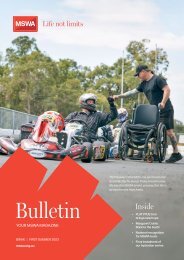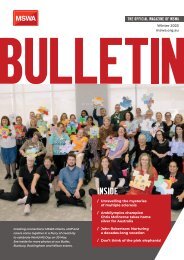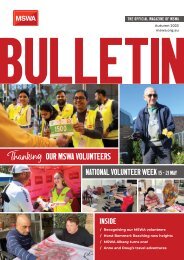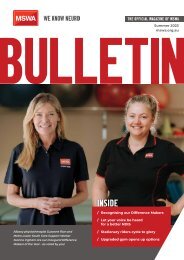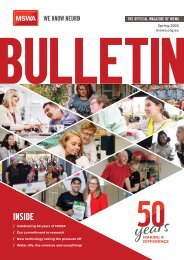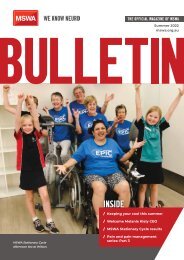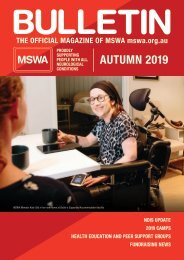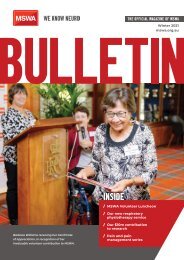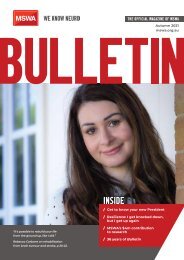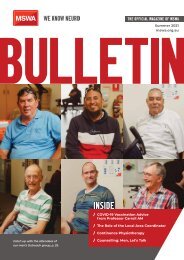MSWA Bulletin Magazine Spring 2021
What is assistive technology and how can it help you? | Good health monitoring practices | Pain and pain management series: Part 2 | Farewell Marcus Stafford
What is assistive technology and how can it help you? | Good health monitoring practices | Pain and pain management series: Part 2 | Farewell Marcus Stafford
You also want an ePaper? Increase the reach of your titles
YUMPU automatically turns print PDFs into web optimized ePapers that Google loves.
COUNSELLING<br />
CONNECTING<br />
WITH NATURE<br />
It was a long, wet winter and many of us are feeling the effects of a lack of sunlight and being<br />
‘stuck inside’. The effects of seasonal affective disorder (SAD) have been well documented,<br />
where the lack of getting outside and the impact of low vitamin D impacts our mental and<br />
physical health.<br />
I have written before about the<br />
benefits of animals on your mental<br />
and physical health. I am now<br />
inviting you to expand this, to<br />
incorporate the natural world. The<br />
medical profession is beginning<br />
to recognise the benefits of<br />
connecting with nature. Treatment<br />
rooms and waiting rooms are<br />
displaying images of nature on<br />
the walls, incorporating sounds of<br />
nature (such as water and birds)<br />
and going as far as providing<br />
subtle scents of nature, which<br />
has increased positive outcomes<br />
for patients.<br />
Humans have an innate appreciation<br />
of close contact with nature, which<br />
is believed to have derived from<br />
the living conditions under which<br />
humans evolved. In other words, the<br />
need to connect with nature is in<br />
our DNA. The value and importance<br />
of our connection to nature is<br />
nothing new as historically many<br />
cultures have included aspects of<br />
nature and the use of medicinal<br />
plants into their wellbeing and<br />
health practices. However, there is<br />
now clear scientifically researched<br />
evidence for the beneficial effects<br />
of exposure to nature and green<br />
environments and the resulting<br />
feelings of wellbeing this can<br />
produce.<br />
There are many ways to get<br />
outside – gardening is a popular<br />
pastime for many. In fact, scientists<br />
have suggested that a type of<br />
friendly bacteria found in soil may<br />
affect the brain in a similar way<br />
to antidepressants! I would not<br />
suggest eating dirt, however getting<br />
your hands and feet into the soil is a<br />
great way to increase exposure and<br />
activate those chemicals in your<br />
brain that improve your mental<br />
and physical health. Alternatively,<br />
going for a walk or ride in the bush<br />
or park, going to the beach, or even<br />
a picnic outdoors are a few of the<br />
many ways you can connect with<br />
the natural world.<br />
If getting physical outside is beyond<br />
your capabilities maybe try sitting<br />
outside with a book or just sitting<br />
mindfully, while engaging fully<br />
with the sights, sounds, smells, and<br />
textures that surround you.<br />
So, venture forth into the<br />
‘great outdoors’ in whatever<br />
way you can. Your physical<br />
and mental health will thank<br />
you for it.<br />
For those of you who would like<br />
to investigate this subject further<br />
there is a document online called<br />
‘Beyond Blue to Green’ which is<br />
an Australian paper developed<br />
by Beyond Blue and the Deakin<br />
University.<br />
KAREN BROWN<br />
<strong>MSWA</strong> COUNSELLOR<br />
17





